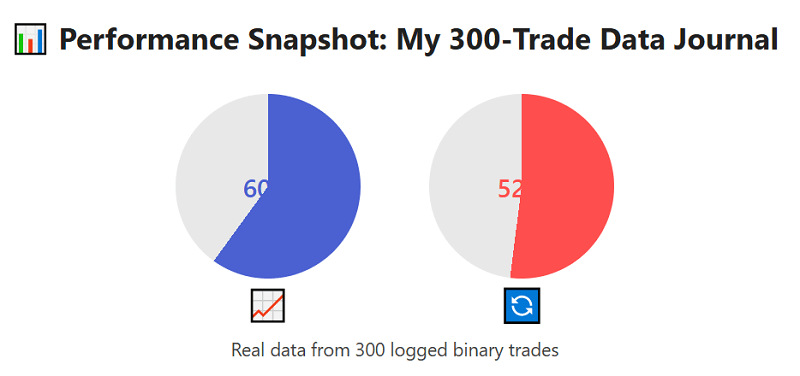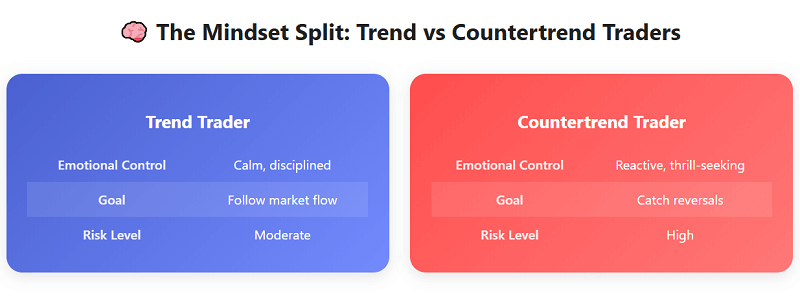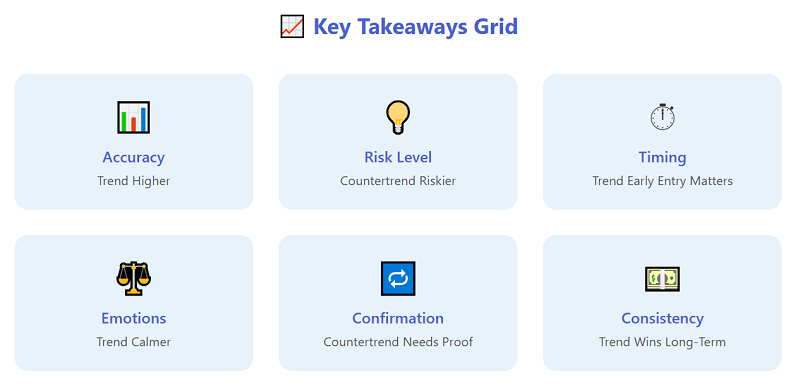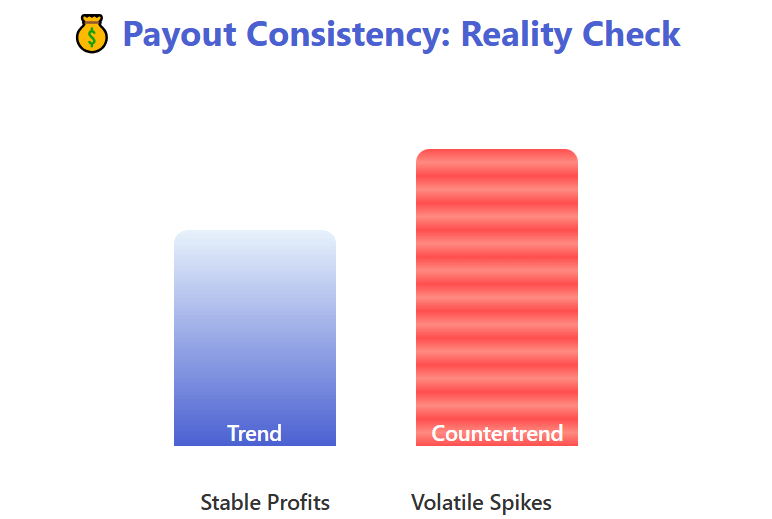Trend vs Countertrend Trading in Binary Options: My Trial, Triumphs and Truths

I still remember the session on March 17, 2025, when I entered a Call on a 5-minute binary using what seemed to be a strong trend signal. The price had broken higher in EUR/USD and looked ready to continue. I clicked “Call,” expecting the momentum to carry me forward, but instead, the move reversed sharply and I lost. It was my second trade of the day, and my confidence took a hit. That was the moment I realized that trading trend style and trading countertrend style might look similar on charts but behave very differently in real binary options trading.
From that loss onward, I started logging every trade, whether it followed the trend or went against it. Over time, I built a journal of how both styles performed in live markets. Here, I’ll share what I learned from that journey, the trades that worked, the ones that hurt, and which approach actually paid more in the end. If you want to try the same strategies live, you can open a Pocket Option account with my affiliate link and see how these setups behave under real conditions.
Why the Traditional Debate Misses the Point
Most articles online about Trend vs Countertrend Trading focus on swing or forex trading. They ignore the demands of short-term binary options, where trades expire in minutes, not hours. Many guides define countertrend trading as entering against the main direction when expecting a correction, and trend trading as simply following the broader movement. What they rarely show is how these decisions unfold on 1- to 15-minute expiry trades.
When I tested both styles in real time, I quickly realized that timing mattered far more than theory. Trend setups often failed because I entered too late, while countertrend setups worked only when the market had clearly exhausted itself. I found a massive gap between what I read online and what happened in my trades..
How I Tested Both Styles
I treated this project like a personal experiment. I defined two clear strategies.
Trend Style
- Direction: trade with the prevailing short-term trend
- Expiry: mostly 3- to 5-minute binaries, occasionally up to 15 minutes
- Trigger: pullback to support or resistance, then continuation with momentum
Countertrend Style
- Direction: against short-term trend, expecting exhaustion
- Expiry: similar short durations
- Trigger: overbought or oversold readings, divergence, or reversal candles near levels
Every trade was recorded with details like asset, time, expiry, entry reason, and result. Over time, patterns emerged. I saw where each style thrived and where it broke down.

Lessons from Trend Trading
During one London session in April, EUR/JPY was trending up cleanly. After a brief pullback, I entered a Call as the price resumed its move. The trade expired in the money. That was the kind of flow I wanted to capture.
Trend trading worked best when I entered early in a new move, not when I chased an overextended breakout. The advantages were clear:
- The direction bias was simple.
- Price action aligned with the overall movement.
- Fewer emotional reversals during trades.
But it wasn’t perfect. When trends weakened, I often entered too late and lost. One mistake came on a stock index breakout where the move had already run its course. The moment I entered, volatility dropped and the trend faded. The trade expired out of the money.
After several cases like that, I learned to wait for pullbacks instead of chasing candles that looked strong but lacked real energy.
Lessons from Countertrend Trading
Countertrend trading attracted me because of the excitement. I wanted to catch tops and bottoms. I remember one night in 2024 trading a commodity index that had spiked upward for hours. RSI was extreme, a long upper wick formed, and I entered a Put. The reversal came fast and paid instantly. That was the thrill of countertrend trading.
But just as quickly, I learned its danger. On gold in May 2025, I entered another Put expecting a reversal. Instead, the uptrend continued for three more candles. Loss. I realized that trading against momentum is like standing in front of a moving train. Sometimes you catch it perfectly, but often, you get hit.
To make countertrend setups safer, I began using confirmation signals. These included double tops or bottoms, wicks rejecting strong levels, and RSI divergence that persisted for multiple candles. I also cut my position size in half for every countertrend entry.
Trend vs Countertrend: What the Data Showed
After 300 trades logged in my journal, the pattern became clear. Trend style had more consistent wins, while countertrend style had higher risk but occasionally higher reward.
| Style | Number of Trades | Win Rate | Payout Consistency | Common Reason for Loss |
| Trend Trading | 180 | 58–60% | Steady | Entering too late in the trend |
| Countertrend | 120 | 50–53% | Volatile | Reversal fails or trend resumes |
The numbers don’t tell the whole story, though. Trend trades often gave me confidence and structure. Countertrend trades gave excitement and potential for quick wins—but also frustration when reversals didn’t come.

If you want to test these insights yourself, you can sign up for Pocket Option, use the 50% deposit bonus, and practice both styles on demo and live charts.
When Trend Trading Works Best
Trend trading shines in markets with steady momentum—currencies during London or New York overlap, trending indices, or volatile synthetic assets. I look for:
- Pullback into trend direction
- Momentum candles confirming continuation
- No nearby resistance or support that could block movement
In these conditions, trend trading feels like following the river rather than swimming against it.
When Countertrend Trading Works Best
Countertrend trading is most effective when volatility is stretched. Markets cannot trend forever. After long one-sided runs, you’ll often see price rejection wicks, RSI divergence, or volume tapering. These moments invite short-term reversals, which can be ideal for 1- to 3-minute binaries.
Still, success here depends on confirmation. I wait for at least one strong rejection candle before entering. Patience saves money in this style.

Comparing Emotions in Both Styles
Trading trend style feels calm and methodical. I focus on structure and wait for pullbacks. Countertrend, on the other hand, is emotional. It tempts you to predict tops and bottoms. When it works, it feels brilliant. When it doesn’t, it feels foolish.
Through my trading journal, I discovered that my mindset often performed better with trend trades. They required less prediction and more reaction.

The Turning Point: Choosing My Style
By mid-2025, after hundreds of trades, I finally accepted that trend style suited me better. It offered stability, higher accuracy, and a rhythm I could manage even during stressful sessions. Countertrend style still had its place but more as a specialty play when the market screamed exhaustion.
I began to base my daily plan around trend opportunities. Whenever I identified a clean trend and momentum confirmation, I traded. When the market chopped sideways or looked overextended, I stepped aside or switched to smaller, cautious countertrend positions.
Lessons That Changed My Results
- Trade early in the trend, not at exhaustion.
- In countertrend setups, demand confirmation, not guesses.
- Skip trades in ranging or noisy markets.
- Never risk more because one style feels “due” to win.
These rules helped me smooth my equity curve and remove emotional spikes.

Key Takeaways
| Aspect | Trend Trading | Countertrend Trading |
| Accuracy | Higher on average | Lower but faster payoff potential |
| Emotional Control | Easier | Harder |
| Learning Curve | Moderate | Steep |
| Best Market Type | Trending | Overextended or exhausted |
| Risk Level | Moderate | High |
The Real Answer: Which Pays More?
For me, trend trading paid more not just in profit, but in peace of mind. Countertrend trades gave the occasional adrenaline-filled win, but my trend setups delivered consistent outcomes.

However, that doesn’t mean countertrend trading has no place. Some traders thrive on reversals. What matters is data, discipline, and understanding which environment suits you.
If you’re ready to explore this yourself, open your Pocket Option account, claim the 50% deposit bonus, and start testing both approaches side by side. Track your results honestly. Let the market show you what fits your personality and discipline.
Final Thoughts
Trend vs Countertrend Trading in Binary Options taught me one big lesson: there is no universal winner, only what fits you best. I still trade both styles occasionally, but I know which one pays more in the long run for my temperament.
Every trade adds data to your understanding. Keep your journal, study your patterns, and remember—patience and consistency will always pay more than prediction.
When you’re ready to put these lessons into practice, sign up for Pocket Option, use your 50% bonus, and start building your own trading story, one real decision at a time.